
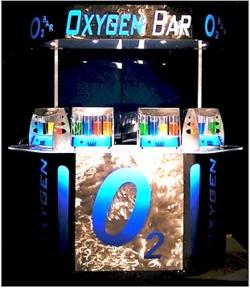 All Pond Life Needs Oxygen
All Pond Life Needs Oxygen
Not only do these organisms demand oxygen, they must receive it insufficiently high concentrations so that the function and health of the pond is maintained. Diverse populations of micro-organisms as well as fish rely on a supply of oxygen.
Please note: The following information is from Ben Helm's excellent UK website at Water Gardener's Bible
Deny them oxygen, and the water quality will deteriorate; add extra and the pond will explode into life.
Without oxygen, filter bacteria cannot oxidize (and detoxify) ammonia into nitrite and then into nitrate. If a pond or filter are allowed to become oxygen deficient for any period of time, anaerobic conditions will prevail causing unstable water conditions and the tell-tale bad-egg smell.
So how do we best use those devices that are available to us as fish keepers to add extra oxygen into our demanding ponds? How do they work, and how can we measure how efficient and effective we are at adding extra aeration?
Dissolving Oxygen Into Pond Water
The physical nature of water puts limitations on how much oxygen we can expect our pond water to hold. It also sets targets for what we should expect to achieve under different pond conditions. In the air we breathe, there is approximately 21% oxygen (210,00ppm oxygen).
In any natural water body, we will typically find less than 1% dissolved oxygen. So tiny are the concentrations of dissolved oxygen in pond water, that their levels are measured in milligrams per litre or parts per million (ppm). For example 3 milligrams of oxygen dissolved in a litre of water equates to 3 ppm.
Higher Temperature
As water temperature rises, its ability to dissolve oxygen reduces.
Lower Temperature
Water will dissolve greater levels of oxygen.
Water Temperature and Fish Metabolism
Fish metabolic rate is dependent on water temperature. In winter their metabolism slows right down and speeds up as the water gets warmer in spring. This dependence on water temperature also affects their immune system, wound healing and digestion.
For most cold water fish, the immune response is severely inhibited below 12°C (54°F) Even when water temperatures start to rise there is a time lag of a week or so before the fish immune system starts to function effectively.
This is one of the reasons that fish are particularly vulnerable during spring, when water temperatures often hover around the 12° -15° C mark for several weeks. Unfortunately fish parasites and opportunistic bacteria tend to become active a lot quicker as temperatures start to rise and often take advantage of sluggish fish.
Other Solutes
The presence of other solutes in the pond will also have a negative effect on achievable DO levels. This would include salt, as well as liquid pond treatments. All the more reason to aerate vigorously under treatment conditions.
Saturation Levels
These physical factors will determine how much DO. your pond water body will be able to hold, setting the levels at which pond water will become saturated with oxygen.
As temperature lowers water will dissolve greater levels of oxygen, making it more difficult for your aeration systems to completely saturate your water. Conversely, at high water temperatures, saturation can be achieved more easily as water can only hold reduced levels of DO.
By taking into account the saturation levels of pond water under different conditions, it is then possible for you to measure the effectiveness of your aeration system.
For example, at 10°C, the water's approximate saturation level will be 11.3 milligrams per litre where at 20°C it will be 9.2 milligrams per litre. You can quickly measure the saturation level of your own pond by using the table below and substituting your pond's temperature and oxygen readings.
The closer your saturation figure is to 100%, the better your system is performing. Could your aeration system be performing better?
The higher the DO the better as long as it is not over the waters saturation point. Koi being members of the Carp family, compared to some other fish species, require relatively low levels of DO (6 milligrams per litre).
Average minimum oxygen requirements of fish (mg/l)
|
Water Temperature
|
Maximum Available D.O
|
Minimum DO Requirement
|
|
05°C (41°F)
|
12.8 mg/l
|
9.1 mg/l
|
|
10°C (50°F)
|
11.3 mg/l
|
8.8 mg/l
|
|
15°C (59°F)
|
10.2 mg/l
|
8.3 mg/l
|
|
20°C (68°F)
|
9.2 mg/l
|
7.8 mg/l
|
|
25°C (77°F)
|
8.2 mg/l
|
7.5 mg/l
|
|
30°C (86°F)
|
7.4 mg/l
|
6.9 mg/l
|
The table shows that as water temperatures increase the gap between the level of dissolved oxygen and the minimum oxygen demand of the fish closes. It is worth noting that under low oxygen conditions (hypoxia), the biggest fish will suffer the most because they have a greater oxygen demand. At high temperatures it is important the system is well oxygenated - even more so at night when plants stop releasing oxygen and in fact remove it from the water.
Effect on Fish of High Water Temperature and Low Oxygen Solubility
The solubility of oxygen in water reduces as temperatures increase. Conversely, because of an increased metabolic rate the oxygen requirement increases as water temperatures increase. Clearly, if the total oxygen demand of the system, which includes fish, bacteria and submerged plants, exceeds the dissolved oxygen levels the fish are likely to suffer.
Although in a well-aerated pond this would be unusual, it can happen when:
Moving/Flowing Water
Oxygen dissolves better in water that is more highly energized (eg flowing, falling and cascading). In a natural environment, more energetic water courses such as mountain streams are higher in DO than lowland rivers, and besides the oxygen that is released by aquatic plants, water movement is the only method by which water can naturally become oxygenated.
In a fish pond, a waterfall can be an effective means of aerating the water but in an intensively stocked pond, can lead to limitations.
Oxygenated water that enters the pond at the waterfall will rarely sink to lower layers of water, being effective only at the surface. Furthermore, the physical work required to move water to oxygenate is significantly less efficient than moving air, especially when it only affects the upper layers of a pond.
Venturi
This method is most easily installed through the wall of a pond from a final filter chamber. A venturi is a cylindrical hollow tube with a unique shape through which water is pumped. The unique shape is often referred to as an hour glass by which the diameter of the tube entrance tapers down to a smaller diameter, and finally returns to its original diameter.
The effect that the internal taper has, causes the velocity of the pumped water to increase. At the minimum diameter (or throat) of the venturi, the pressure drops only to eventually recover by the end of the venturi tube. If the pressure loss is sufficient at the throat, then a small hole at the throat connected to atmospheric air to be sucked into the returning pumped water, literally injecting air into the pumped returned water.
A venturi can look quite impressive as an aeration device, but in fact, compared to air pumped into the pond water directly, are relatively inefficient aeration devices. They are energy inefficient in that they involve the pumping of water rather than air and the bubble size is very large. This means that the rates of oxygen diffusion will be reduced. The large bubble size also means that only the upper layers of water receive the full benefit of the freshly oxygenated water.
Diffused Aeration
There are many different types of diffusers available to the fish keeper, ranging from the basic (and disposable) airstone to other larger (and permanent) self-cleaning diffusers. Typical diffused aeration provides a constant stream of air bubbles, rising through the water column. A fine bubble size is essential to provide the maximum surface area for efficient oxygen transfer.
For example, if a bubble size of 1/4" is reduced to a fine bubble a quarter of that size (1/16") the surface area is increased by a huge factor of 16. Even if some air diffusers look impressive by the sheer volume of large bubbles they are relatively inefficient as they provide a relatively small surface area for gas exchange and most of the pump energy is used to blow air back into the atmosphere. Contact time between air and water as bubbles rise through the water column is also important. As water depth increases, contact time also increases combined with the increased head of pressure providing better physical conditions for dissolving oxygen into water.
This rising column of fine bubbles ensures the mixing and circulation of significant volumes of water. This mixing action enhances water quality by making the pond a well-aerated, homogenous and stable environment. Fine bubble aeration also reduces surface agitation, permitting continued and undisturbed viewing of your fish.
Traditional air diffusers (airstones) are perhaps now regarded as inefficient because as the volume of air supplied is increased to increase aeration, the bubble size increases reducing gas exchange rates. They are also prone to clogging and blocking up, reducing airflow considerably.
A relatively new and unique flexible rubber diffuser (called an airdome) is now available which has been specifically developed to satisfy all the necessary criteria for optimum gas exchange. In addition the flexible nature of the unit has self-cleaning properties that ensure optimum efficiency during long-term use. This can be fitted onto a bottom drain where it aerates the pond from the bottom, giving enhanced aeration in addition to mixing of the whole water column, enhancing the removal of waste towards the bottom drain.
The levels of DO achievable in fish ponds are determined by natural physical conditions, particularly water temperature. There are various options when choosing an aeration device, with some methods proving more efficient and effective than others. The most efficient method by far is using diffused aeration, but the overall performance is still determined by the careful selection of air pump and diffuser.
Aeration Solutions
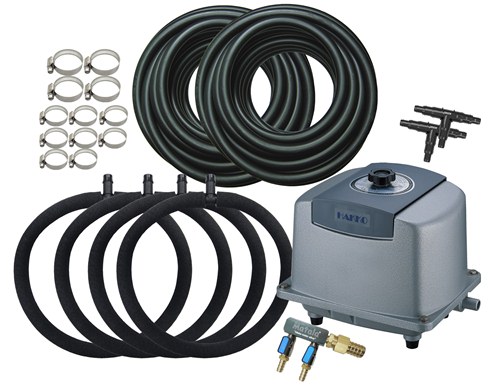 Matala Aeration Kits Matala Aeration Kits |
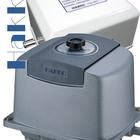 Hakko Air Pumps |
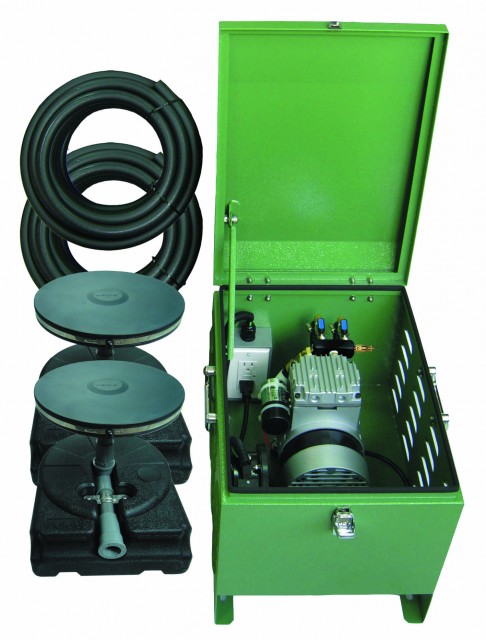 Aeration Kits for Large Ponds |
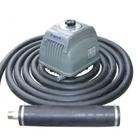 Aeration devices |